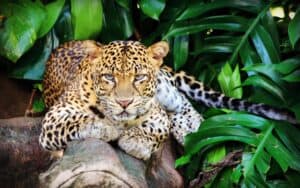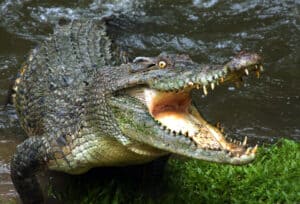Cats of all sizes are known for their stealth, agility, and speed. We all know cheetahs take the cake when it comes to their record-breaking speed. But what about leopards? They are quick climbers, sneaky hunters, and pretty fast on land, but just how fast?
Leopards can run up to speeds of 36 miles per hour. Below, we delve into how that speed compares to their fellow felines and what contributes to a cat’s incredible speed and agility.
How Fast Are Leopards Compared to Other Big Cats?

Unlike cheetahs, which have filled-in spots, leopards have spots that are more rosette-shaped.
©Anup Shah/DigitalVision via Getty Images
Leopards are actually one of the slowest of the big cat species. These are also the smallest of the big cats, with females ranging from 46-132 pounds and males weighing between 80-165 pounds. Both are only just over two feet tall at shoulder height. Their small build might contribute to their slow speeds in comparison to other big cats, but leopards shine in their climbing abilities.
Despite their similarities in size, cheetahs are twice as fast as leopards. Cheetahs are the fastest land mammals and can run in bursts up to 80 miles per hour. This excess in speed could be due to their leg muscles and structure. Leopards are more accustomed to tree climbing and have shorter, thicker legs to efficiently do this. Cheetahs hunt in wide-open areas and don’t have as many reasons to climb, so their legs are slenderer and longer, therefore they can cover much more ground at a quicker pace than their similar-looking small cat counterparts. The thick legs of a leopard also allow them to drag their kills into trees. Cheetahs are unfortunately not strong enough to do this and instead rely on hiding and eating their kills within bushes or tall grass.
When it comes to swiftness, other big cats are within the range of leopards and cheetahs. Tigers can run between 30-40 miles per hour, and lions 50 miles per hour. Snow leopards are not much faster than their “regular” leopard relatives, maxing out at around 40 miles per hour.
How Fast is a Leopard Compared to a Human?
The fastest human runner, Usain Bolt, maxes out at 27.5 miles per hour. While that’s extremely impressive for a human, those speeds are not impressive to any member of the Felidae family, even leopards. However, humans have much more endurance when it comes to running, though not at the speeds Usain Bolt reaches. When comparing how long a human can run versus how long a cat can run, the human wins. Some factors that give humans an advantage in endurance include bipedalism, tons of sweat glands, and the ability to conserve energy while running. This could stem from an evolutionary need to continuously pursue prey by essentially outrunning it. Meanwhile, the cat only needs a burst of speed to caught prey.
How Fast is a Domestic House Cat?

Many cat owners can likely attest to their cat getting the “zoomies” at sub-optimal times of the night.
©Nils Jacobi/Shutterstock.com
Perhaps the most applicable question for cat lovers is how fast a domestic house cat can run. Surprisingly, they can reach speeds of up to 30 miles per hour, which is just six miles per hour slower than a leopard. Domestic house cats are just smaller versions of their wild counterparts!
Housecats and large, wild cats share quite a few similarities. In fact, some “big cats” can purr. The larynx causes the hyoid bone to vibrate in housecats and smaller “big cats” like cougars and bobcats. However, they can’t roar. That is an honor saved for the true “big cats” like lions and tigers. Despite their size difference compared to a regular house cat, cougars, lynx, and bobcats are not considered “big cats”. Their vocalizations, including an inability to roar, are a distinguishing characteristic between so-called “big” and “small” cats.
Why Are Cats So Fast?
Cats of all sizes can reach impressive speeds. These are all attributes of their anatomy. Much like how the strength of an animal’s bite is due to their jaw and skull anatomy, a cat’s speed is determined by their musculature and skeletal composition. However, you can boil down their speed and agility to a very important structure: the spine.
Cats have an element of elasticity to their spine that can help them extend and flex with every stride. This springy movement helps propel them forward quickly and with force. Their claws also give them traction to avoid slipping when making quick turns or movements. Other elements of their anatomy, like tiny collarbones and unhindered shoulder blades, contribute to their contortionist ability. All cats have this type of anatomy which explains their explosive jumps and excessive speed.
The photo featured at the top of this post is © Rudi Hulshof/Shutterstock.com
Thank you for reading! Have some feedback for us? Contact the AZ Animals editorial team.






